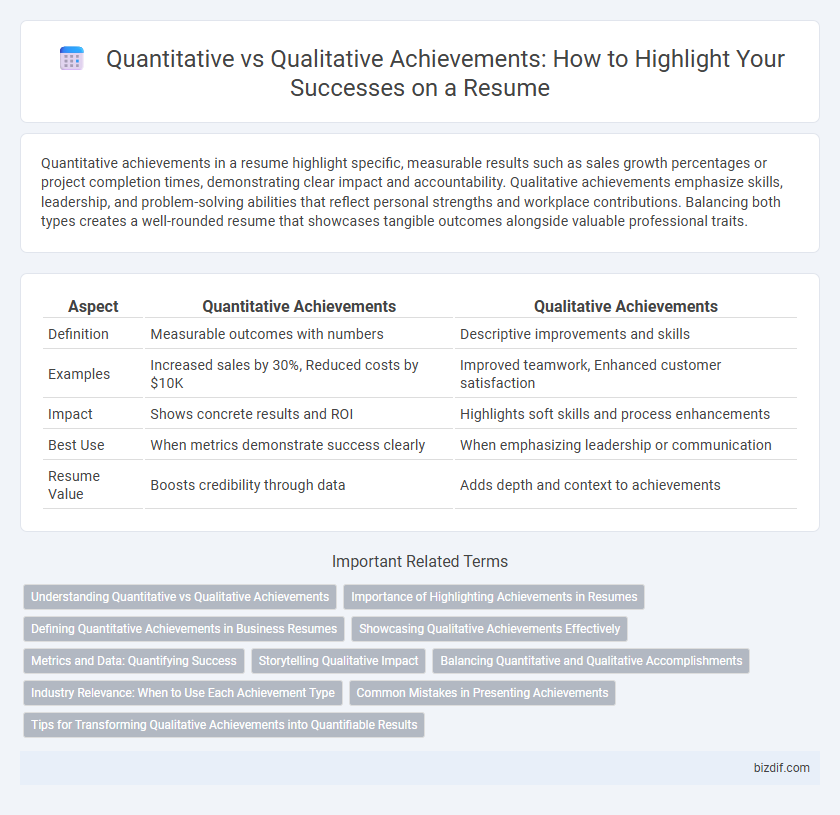Quantitative achievements in a resume highlight specific, measurable results such as sales growth percentages or project completion times, demonstrating clear impact and accountability. Qualitative achievements emphasize skills, leadership, and problem-solving abilities that reflect personal strengths and workplace contributions. Balancing both types creates a well-rounded resume that showcases tangible outcomes alongside valuable professional traits.
Table of Comparison
| Aspect | Quantitative Achievements | Qualitative Achievements |
|---|---|---|
| Definition | Measurable outcomes with numbers | Descriptive improvements and skills |
| Examples | Increased sales by 30%, Reduced costs by $10K | Improved teamwork, Enhanced customer satisfaction |
| Impact | Shows concrete results and ROI | Highlights soft skills and process enhancements |
| Best Use | When metrics demonstrate success clearly | When emphasizing leadership or communication |
| Resume Value | Boosts credibility through data | Adds depth and context to achievements |
Understanding Quantitative vs Qualitative Achievements
Quantitative achievements in resume writing emphasize measurable results such as percentage increases in sales, revenue growth, or the number of projects completed, providing clear evidence of performance impact. Qualitative achievements highlight skills, leadership abilities, and improvements in processes or customer satisfaction, which are crucial for demonstrating personal contributions and workplace culture fit. Understanding the distinction helps tailor resumes to showcase both data-driven outcomes and meaningful professional qualities effectively.
Importance of Highlighting Achievements in Resumes
Highlighting achievements in resumes significantly boosts candidate appeal by demonstrating tangible impact and measurable success. Quantitative achievements provide clear evidence through data points like increased revenue, percentage growth, or cost savings, making skills and contributions objectively visible to employers. Qualitative achievements emphasize personal strengths, leadership, and problem-solving abilities that support the quantitative metrics, creating a balanced and compelling professional profile.
Defining Quantitative Achievements in Business Resumes
Quantitative achievements in business resumes refer to measurable results that demonstrate the impact of your work, such as increasing sales by 30%, reducing costs by 15%, or boosting customer retention rates by 20%. These data-driven accomplishments provide concrete evidence of your success and help employers gauge your effectiveness. Highlighting specific numbers and percentages strengthens your resume by showcasing proven performance and value.
Showcasing Qualitative Achievements Effectively
Showcasing qualitative achievements effectively involves highlighting skills such as leadership, creativity, and problem-solving that demonstrate an applicant's impact beyond numbers. Use specific examples that illustrate improvements in team morale, client satisfaction, or innovation to provide context and depth to your accomplishments. Emphasizing these outcomes helps employers understand the value you bring through intangible contributions.
Metrics and Data: Quantifying Success
Quantitative achievements in resume writing emphasize measurable metrics such as percentages, revenue growth, or project completion rates, demonstrating clear, data-driven success. Qualitative achievements focus on skills, leadership, and problem-solving abilities, highlighting the impact beyond numbers. Incorporating specific data points like increased sales by 30% or improved customer satisfaction scores by 15% effectively quantifies success and enhances credibility.
Storytelling Qualitative Impact
Storytelling qualitative impact in resume writing emphasizes the narrative behind achievements, showcasing problem-solving skills, leadership, and personal growth that numbers alone cannot capture. Highlighting qualitative achievements like team collaboration, innovation, and adaptability resonates with hiring managers by illustrating real-world contributions and cultural fit. These impactful stories complement quantitative data, offering a comprehensive view of professional value beyond mere metrics.
Balancing Quantitative and Qualitative Accomplishments
Balancing quantitative and qualitative achievements in a resume ensures a comprehensive representation of a candidate's impact, combining measurable results like sales growth or project completion rates with qualitative strengths such as leadership, creativity, and problem-solving skills. Highlighting numerical data alongside descriptive achievements helps recruiters assess both the candidate's efficiency and their ability to drive innovation and foster team collaboration. This balanced approach enhances resume effectiveness by showcasing tangible outcomes and the underlying qualities that contribute to sustained success.
Industry Relevance: When to Use Each Achievement Type
Quantitative achievements, such as "increased sales by 30%," are essential in industries like finance, marketing, and sales where measurable results demonstrate impact. Qualitative achievements, including "enhanced team collaboration and leadership," resonate more in creative, educational, or management roles where soft skills and process improvements drive success. Tailoring resume content by industry relevance ensures recruiters quickly identify critical contributions aligned with their field's priorities.
Common Mistakes in Presenting Achievements
Common mistakes in presenting achievements on a resume include vague descriptions lacking measurable results or specific impact, which dilute the effectiveness of the accomplishment. Candidates often fail to quantify their successes using relevant metrics such as percentages, revenue growth, or process improvements, reducing clarity for hiring managers. Overemphasis on qualitative statements without clear evidence can make achievements appear subjective or unsubstantiated.
Tips for Transforming Qualitative Achievements into Quantifiable Results
Highlight specific metrics such as percentages, dollar amounts, or timeframes to convert qualitative achievements into measurable results, increasing the impact on resumes. Use data-driven language by tracking improvements like "increased client retention by 20%" or "reduced processing time by 30 hours monthly" to provide concrete evidence of success. Incorporate performance indicators and benchmarks relevant to your industry to clearly demonstrate the value brought to previous roles.
Quantitative Achievements vs Qualitative Achievements Infographic

 bizdif.com
bizdif.com